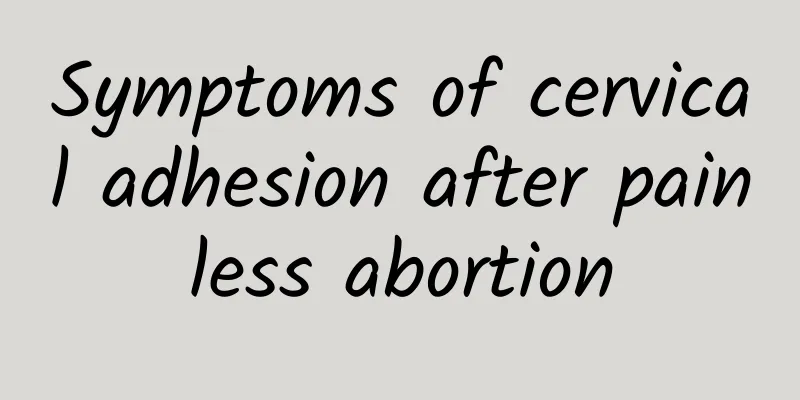Symptoms of cervical adhesion after painless abortion

|
If cervical adhesions occur after painless abortion, common symptoms include decreased or absent menstruation, lower abdominal pain, infertility, etc. If you have the above symptoms, it is recommended to see a doctor as soon as possible to avoid delaying treatment and causing more serious consequences. Cervical adhesions are mainly caused by surgical damage to cervical tissue, which leads to fibrotic healing and partial or complete occlusion of the cervix. Common symptoms are abnormal menstruation, among which reduced menstrual volume is the earliest signal. Some patients may even experience amenorrhea. This is because the cervical canal is blocked and menstrual blood in the uterus cannot be discharged smoothly, which may be accompanied by periodic lower abdominal pain. Infertility is also an important signal of cervical adhesions, because the cervical canal is blocked and the combination of sperm and egg is affected. Some women may experience compression symptoms such as periodic frequent urination and urgency, which is due to increased pelvic pressure caused by uterine blood accumulation. If cervical adhesions are suspected, common examination methods include ultrasound examination, hysteroscopy, etc., which can clarify the degree and location of adhesions. The treatment method for cervical adhesions can be selected according to the specific situation. For example, mild adhesions can be treated with hysteroscopic separation to restore the adhesion site to normal; if it is moderate to severe adhesions, it may be necessary to place an intrauterine contraceptive device or balloon in the uterine cavity after surgery to prevent re-adhesion; severe adhesions may require a combination of drug treatment, such as hormonal drugs to restore the endometrium. Postoperative infection should be avoided. You can take antibiotics prescribed by your doctor to prevent inflammation, but do not take medication on your own. In order to prevent cervical adhesions after painless abortion, regular follow-up examinations are recommended after surgery, especially ultrasound examinations 1 month after surgery to assess the recovery of the uterus. Maintaining good living habits after surgery can help reduce the occurrence of subsequent problems. It is recommended to avoid early sexual intercourse after surgery, at least one month apart, and pay attention to personal hygiene, change underwear frequently, keep the lower body clean, and avoid infection. Eat more foods rich in vitamins C and E, such as oranges, spinach, nuts, etc., to promote tissue repair. If necessary, you can take health supplements under the doctor's advice to promote healing. If you find symptoms such as abnormal menstruation, abdominal pain, etc., you should go to the obstetrics and gynecology department as soon as possible to ensure long-term maintenance of reproductive health. |
<<: How are uterine cysts formed? What are the symptoms?
>>: Can uterine cysts cause peritonitis?
Recommend
How much does it cost to check for pelvic peritonitis?
Pelvic peritonitis is a very common gynecological...
Refuse to be a fat bear Ginger metabolism UP
Do you always hit a plateau in your weight loss a...
Repeated abortions are more likely to cause ectopic pregnancy in women
Due to various reasons, problems occurred during ...
Hormone treatment is usually used to treat menopausal dysfunctional uterine bleeding
Menopausal functional uterine bleeding is mainly ...
Causes of cervical erosion in young girls
Cervical erosion mostly occurs in married women, ...
Diet therapy for vulvar itching
Vulvar itching is also a common symptom that both...
Will early miscarriage occur if ovarian cysts are detected during pregnancy?
Will early miscarriage occur if ovarian cysts are...
How much does it cost to treat functional uterine bleeding?
Gynecologists at the hospital said that a normal ...
Is fasting blood sugar 9.11 accompanied by irregular menstruation diabetes?
Is fasting blood sugar of 9.11 accompanied by irr...
Survey: 45% of parents have used goat milk powder for their babies
Goat milk has many benefits! According to an onli...
What are the symptoms of chronic pelvic inflammatory disease
What are the symptoms of chronic pelvic inflammat...
Is it because women have dark private parts that they are "experienced"? Don't be ridiculous! I'll tell you the truth all at once
Some time ago, a patient of mine came to me myste...
Eat vegetarian food for your health! Keep in mind these 6 key points, nutritionists say…
There are more and more people suffering from dia...
What to use with motherwort to treat uterine fibroids? The efficacy of motherwort in treating uterine fibroids
What to use with motherwort to treat uterine fibr...
You can lose weight even if you sit still! 3 exercises to reduce abdominal distension
This is the evidence of a famous model's post...









